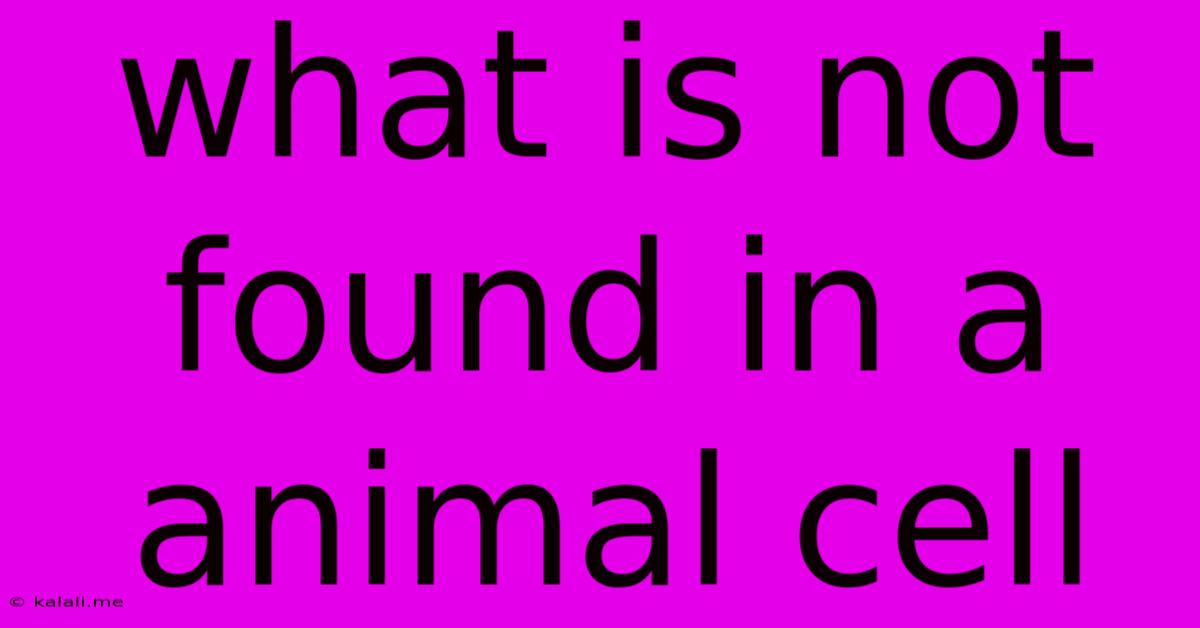What Is Not Found In A Animal Cell
Kalali
Jun 14, 2025 · 3 min read

Table of Contents
What's Missing in Animal Cells: A Comprehensive Guide
Animal cells are the fundamental building blocks of animals, but they lack certain structures found in other cell types, particularly plant cells. Understanding these absences is crucial to grasping the unique characteristics and functionalities of animal cells. This article explores the key components not found in animal cells, providing a clear and concise explanation. This will help you understand the fundamental differences between animal and plant cells, a crucial topic in biology.
Animal cells are eukaryotic cells, meaning they contain a membrane-bound nucleus and other organelles. However, several key structures are absent, significantly impacting their function and overall structure. Let's delve into the most significant omissions:
1. Cell Wall: The Defining Difference
Perhaps the most prominent absence in animal cells is the rigid cell wall. Plant cells possess a tough, protective cell wall made primarily of cellulose, providing structural support and protection. Animal cells, on the other hand, rely on their flexible cell membrane for protection and maintaining their shape. This lack of a cell wall contributes to the diversity of animal cell shapes and sizes. The absence of a cell wall allows animal cells to change their shape more readily, a critical factor in processes like cell migration and movement.
2. Chloroplasts: The Absence of Photosynthesis
Animal cells lack chloroplasts, the organelles responsible for photosynthesis in plants. Chloroplasts contain chlorophyll, a pigment that captures light energy to convert carbon dioxide and water into glucose (sugar), providing the plant with energy. Animals, being heterotrophs, obtain energy by consuming other organisms, rendering chloroplasts unnecessary. This fundamental difference reflects the contrasting metabolic strategies of plants and animals. Understanding this difference is key to appreciating the food chain and energy flow in ecosystems.
3. Large Central Vacuole: Storage and Support
Another significant difference lies in the absence of a large central vacuole. Plant cells typically contain a large, fluid-filled vacuole that occupies a significant portion of the cell's volume. This vacuole plays a crucial role in storing water, nutrients, and waste products, providing turgor pressure that contributes to the plant's structural support. Animal cells possess smaller vacuoles, if any, which perform more specialized functions. The reduced storage capacity compared to plant cells impacts how animal cells manage water and waste.
4. Plasmodesmata: Intercellular Communication
Plasmodesmata, channels that connect adjacent plant cells, allowing for communication and transport of materials between cells, are also absent in animal cells. While animal cells communicate through other mechanisms, the lack of plasmodesmata highlights a fundamental difference in intercellular communication strategies. Animal cells use gap junctions and other mechanisms to facilitate communication between cells.
5. Plastids (Other than Mitochondria): Specialized Organelles
Beyond chloroplasts, plant cells contain various other types of plastids involved in storage and pigment synthesis. These diverse plastids are generally absent in animal cells, further emphasizing the metabolic differences between the two cell types. Mitochondria, while often considered plastids, are present in both plant and animal cells; however, the other plastid types are plant-specific.
In summary, the absence of a cell wall, chloroplasts, a large central vacuole, plasmodesmata, and other types of plastids distinguishes animal cells from plant cells. These differences reflect the distinct metabolic pathways, structural requirements, and intercellular communication strategies of these two fundamental cell types. Understanding these absences is essential for a complete comprehension of cell biology and the diversity of life.
Latest Posts
Latest Posts
-
Which Of These Is A Cation
Jun 15, 2025
-
4 Is Subtracted From The Cube Of A Number
Jun 15, 2025
-
What Are A Group Of Stars Called
Jun 15, 2025
-
Which Of The Following Devices Measures Air Pressure
Jun 15, 2025
-
What Is The Difference Between Glycogen And Starch
Jun 15, 2025
Related Post
Thank you for visiting our website which covers about What Is Not Found In A Animal Cell . We hope the information provided has been useful to you. Feel free to contact us if you have any questions or need further assistance. See you next time and don't miss to bookmark.